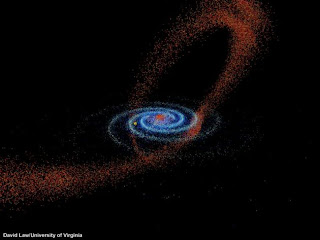Galaxy: Where it’s goes and where it’s from?
Galaxy: Where it’s goes and where it’s from?
What is galaxy? Yes, a galaxy is a system of stars, dust, and gas held together by gravity. Galaxy is the small portion of our universe. Many stars make a galaxy. Typically a galaxy contain ten million (107) to hundred trillion (1014) stars. It depends on galaxies size. Small galaxies have fewer than a billion stars called Dwarf galaxy. Large galaxies have more than a trillion called Giant galaxy. Scientists estimate that there are more than 100 billion galaxies scattered throughout the visible universe. Our solar system is also in a galaxy called the Milky Way.
Picture of our Milky Way
The Milky Way has a diameter of about 100,000 light-years. (A light-year is the distance that light travels in a vacuum in a year about 5.88 trillion miles or 9.46 trillion kilometers). The solar system lies about 25,000 light-years from the center of the Milky Way galaxy. There are about 100 billion stars in the Milky Way. Many galaxies found groups called clusters. A cluster may contain from a few dozen to several thousand galaxies. It may have a diameter as large as 10 million light-years. Many clusters found a group called super clusters.
Cluster
Scientist classifies most galaxies by shape as either spiral galaxies or elliptical galaxies. The Milky Way is a spiral galaxy. All spiral galaxies rotate but slowly. The Milky Way makes a complete revolution once every 250 million years.
Galaxy emits much energy. The energy emitted by galaxies comes from various sources. Much of it is due to the heat of the stars and of clouds of dust and gas called nebulae. All galaxies emit energy as waves of visible light and, infrared rays, X rays other kinds of electromagnetic radiation.
Where galaxy is from? Scientists have proposed two main kinds of theories of the origin of galaxies: (1) bottom-up theories and (2) top-down theories. Bottom-up theories state that much smaller objects such as globular clusters formed first. These objects then merged to form galaxies. And according to top-down theories, large objects such as galaxies and clusters of galaxies formed first. The smaller groups of stars then formed within them. The starting point for both kinds of theories is the big bang, the explosion with which the universe began 10 billion to 20 billion years ago. Big bang theories of galaxy formation agree that no new galaxies or very few have formed since the earliest times. Then other is formed.
Where galaxy is goes? After birth of a child he grows up gradually. At a time he increase and then slowly die. Like human life galaxy also born and grow up, rules her region and then die. And again a new galaxy generate.
Scientists do not understand or discover clearly many things about our universe. There are many things of galaxy yet mysteries.



Comments
Post a Comment